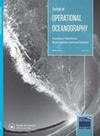在南大洋研究考察期间评估海冰漂移的数值和自由漂移预测:一个操作角度
IF 2.4
3区 地球科学
Q4 METEOROLOGY & ATMOSPHERIC SCIENCES
引用次数: 8
摘要
南极海冰被普遍认为是气候系统的主要参与者,但它也是极地海上安全的重要因素。在适合导航和研究规划的时间尺度上对南大洋海冰进行遥感和预报仍然具有挑战性。在本研究中,从通知航运作业的角度评估了数值海冰漂移预报。进行了一系列试验,以确定一个可操作的全球海洋和海冰模型以及一个简单的自由漂移模型是否能够在较短的准备时间内提供准确的漂移估计。这两种方法都是根据冬季和春季在南大洋边缘冰区进行的两次研究巡航中部署的浮标的冰漂测量结果进行评估的。数值预报模式能较好地预报24 h海冰轨迹,冬季平均定位误差为16.6 km,春季平均定位误差为9.2 km。更简单的自由漂移模型,使用经验优化的风标度,在冬季和春季分别返回15.9和9.3公里的平均位置误差。动力模式和自由漂移模式的模式技能在冬季都比春季低。自由漂移模型技能似乎与海冰巩固有关,这可能有助于确定这种方法何时何地适用。关于海冰在动力模型中的流变表示以及风和海洋强迫的质量的不确定性仍然存在,这可能会影响战术航行时间框架内的模型技能。本文章由计算机程序翻译,如有差异,请以英文原文为准。
Evaluating numerical and free-drift forecasts of sea ice drift during a Southern Ocean research expedition: An operational perspective
ABSTRACT Antarctic sea ice is prevalently seen as a major player in the climate system, but it is also an important factor in polar maritime safety. Remote sensing and forecasting of Southern Ocean sea ice at time scales suitable for navigation and research planning remain challenging. In this study, numerical sea ice drift forecasts are assessed from the perspective of informing shipping operations. A series of tests is performed to ascertain whether an operational global ocean and sea ice model and a simple free-drift model can provide accurate drift estimates over short lead times. Both approaches are evaluated against ice drift measurements from buoys deployed during two research cruises in the Southern Ocean marginal ice zone during winter and spring. The numerical forecast model was able to forecast sea ice trajectories over 24 h with an average position error of 16.6 km during winter and 9.2 km during spring. The simpler free-drift model, using empirically optimised wind scaling, returned an average position error of 15.9 and 9.3 km during winter and spring respectively. Model skill for both the dynamical and free-drift models is lower in winter than in spring. Free-drift model skill appears linked with sea ice consolidation, which may assist in determining when and where this approach is fit for purpose. Lingering uncertainties regarding the rheological representation of sea ice in the dynamical model and the quality of the wind and ocean forcing remain, potentially affecting model skill over tactical navigation time frames.
求助全文
通过发布文献求助,成功后即可免费获取论文全文。
去求助
来源期刊
CiteScore
7.50
自引率
9.70%
发文量
8
审稿时长
>12 weeks
期刊介绍:
The Journal of Operational Oceanography will publish papers which examine the role of oceanography in contributing to the fields of: Numerical Weather Prediction; Development of Climatologies; Implications of Ocean Change; Ocean and Climate Forecasting; Ocean Observing Technologies; Eutrophication; Climate Assessment; Shoreline Change; Marine and Sea State Prediction; Model Development and Validation; Coastal Flooding; Reducing Public Health Risks; Short-Range Ocean Forecasting; Forces on Structures; Ocean Policy; Protecting and Restoring Ecosystem health; Controlling and Mitigating Natural Hazards; Safe and Efficient Marine Operations

 求助内容:
求助内容: 应助结果提醒方式:
应助结果提醒方式:


